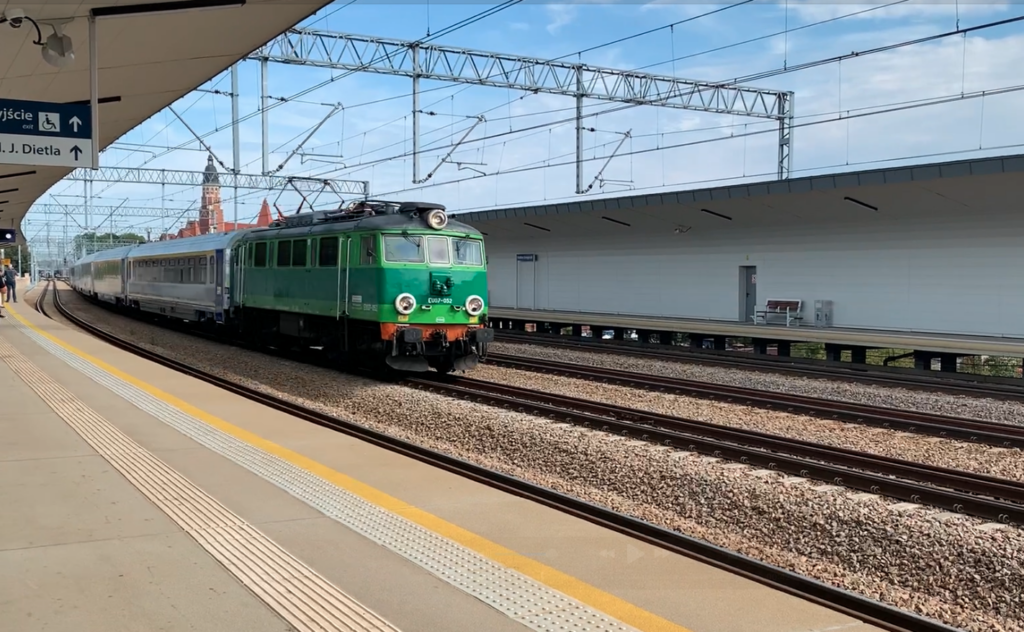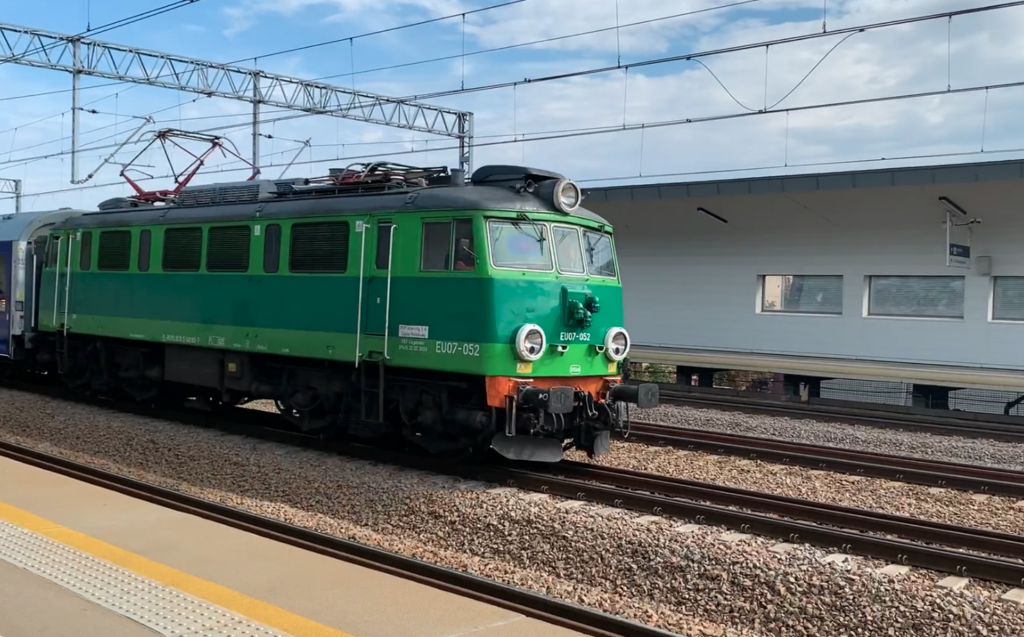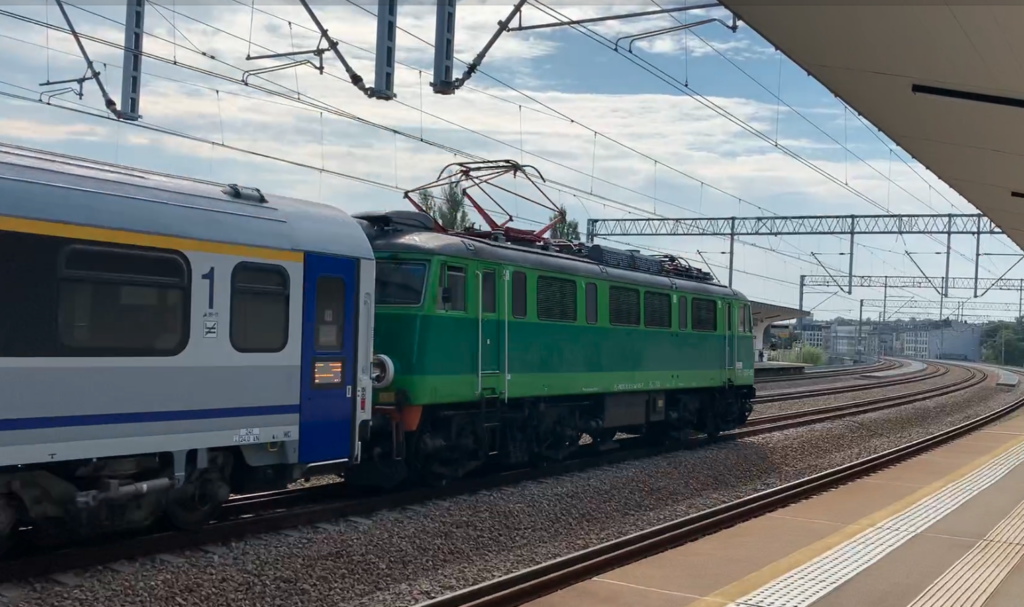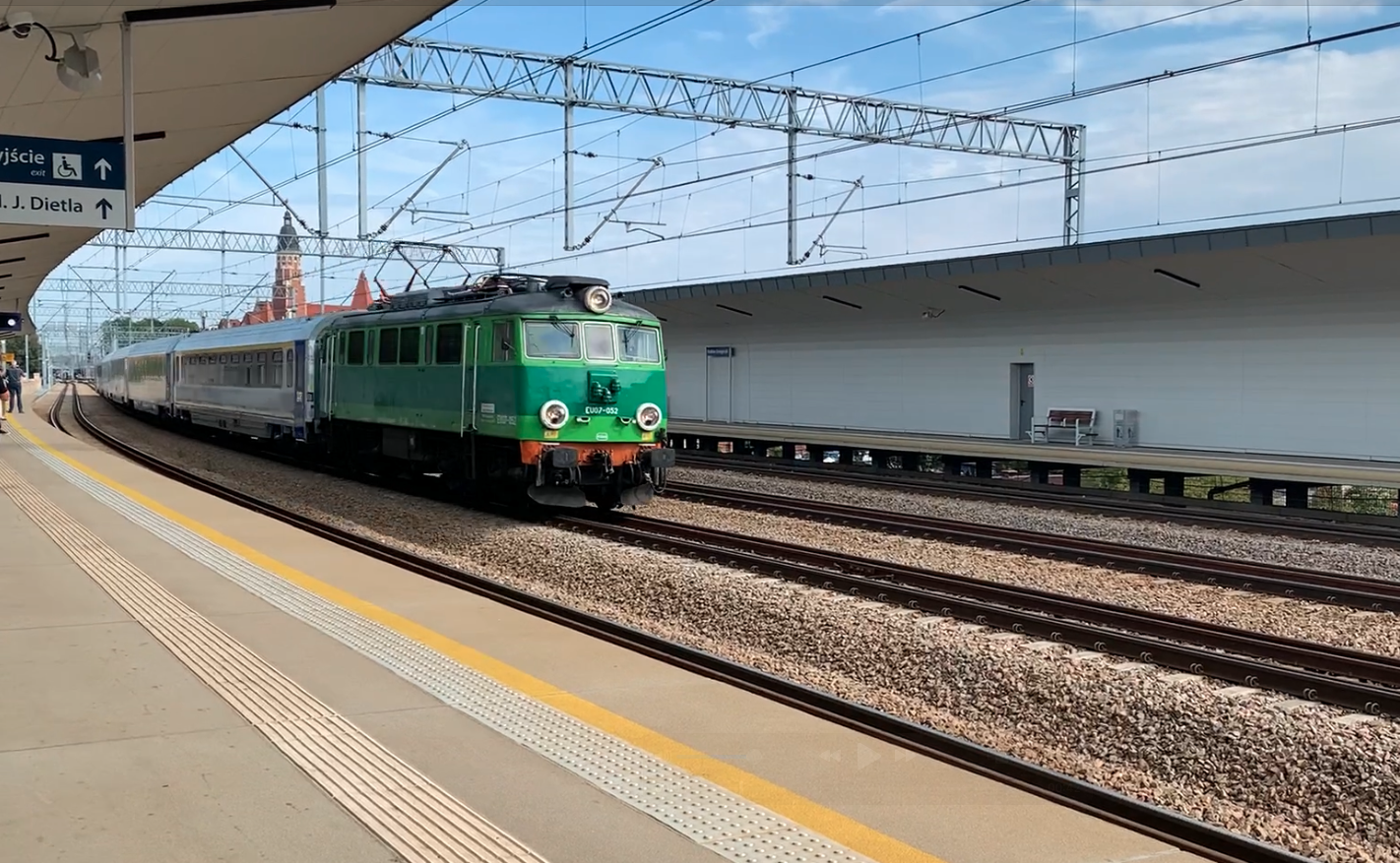Kraków 2025-06-17
Electric Locomotive EU07-052.



At the end of the 50s, electrification on Polish railways was already progressing rapidly. Electric locomotives were needed for passenger and freight trains.
First, Swedish locomotives were purchased, which in Poland were designated EP03. The locomotive was manufactured by Allmann Svenska Elektriska Aktiebolaget and bore the designation ASEA E150. In 1951, 8 units were purchased for PKP. Initially, the locomotives were assigned numbers in the E150 series. In 1951, the series designation was changed to E03, and in 1959, finally to EP03. A copy of the EP03-01 locomotive is in the Railway Open-Air Museum in Chabówka.
A Polish locomotive, Pafawag 1E, was also developed, which in PKP received the designation E02 and finally EP02. In the years 1953–1957, 8 copies of the 1E type were built and given numbers from E110 to E117. The locomotives were built in the State Wagon Factory in Wrocław. However, the EP02 locomotive was not very successful. Its running gear was not good and wore out quickly, at higher running speeds. Therefore, after a few years, the train’s running speed was limited to 70 km/h. The electrical part of the locomotive was good, because it came from the English Electric company. These were English solutions and components, eventually replaced by Polish ones. The experience gained from the operation of the EP02 was used to develop the ET21 type E3 electric locomotive. A copy of the EP02 locomotive can be seen in the Railway Open-Air Museum in Chabówka.
Then locomotives from the GDR were purchased, which in Poland were designated EU04. The factory designation was LEW E04. Initially, PKP assigned the designation type E200, then E04 and finally EU04. These locomotives were built for PKP in 1954–1955, by the LEW Hennigsdorf plant in Hennigsdorf in the GDR. However, these locomotives were unreliable. According to other sources, the locomotives were good, but the German factory was unable to fulfill a larger order for Poland.
In 1961, PKP bought 30 electric locomotives Škoda 44E series 30 in Czechoslovakia, which were designated EU05 in Poland. The locomotives were built at the Škoda plant in Pilzno.
EU06 locomotive.
The search for a manufacturer of more successful locomotives was still ongoing. With great difficulty, the British offer from English Electric was accepted. This company had the most experience in producing this type of vehicle. The choice fell on a locomotive, which in Poland received the designation EU06, series 20. The basis for the EU06 locomotive was the English Electric Class 83 locomotive. 20 units were purchased, as well as a license to produce these locomotives in Poland. The locomotives were built in England in the period 1961-1962, at the Vulcan Foundry plant in Newton-le-Willows in Lancashire, England. In December 1961, PKP representatives carried out the technical acceptance of the first locomotive. In the spring of 1962, the first EU06 locomotive was accepted for use in the locomotive shed in Kraków Prokocim. 19 locomotives were delivered to Poland by the end of 1962, and the last one was transferred in 1965, because it was undergoing modernization work.
The most modern electric locomotive for PKP at that time was built in the oldest locomotive factory in the world. The Vulcan Foundry was founded in 1825 by Mr. Robert Stephenson, son of George Stephenson, the famous designer of steam locomotives.
The EU06 locomotive could pull a 650-ton passenger train at a speed of 125 km/h or a 2,000-ton freight train at a speed of 70 km/h. The locomotive’s power is 2,000 kW. Locomotives of this series could also work in pairs in multiple switchgear and then the train weight could be increased accordingly, even up to 3,600 tonnes.
In accordance with Polish wishes, the EU06 locomotives received rectangular bumpers. Three reflectors were installed in the front wall of the locomotive, which due to their size were called “Buckets”. Additionally, the lower reflectors received red train tail lights inside. There are three windows in the front wall. The external windows received windscreen wipers, the mechanisms of which were mounted above the windows. The multiple control sockets were centrally located on the front wall. Each driver’s cabin received two entrances on the left and right side, unlike in the later EU07. The locomotive received four rear-view mirrors. The engine compartment received three windows and four ventilation grilles in each wall.
The locomotives were painted in the standard painting pattern of the time: light green and dark green. The chassis was painted black. The pantographs are red. The end of the side frame was painted red. The operating and information inscriptions were painted white. Warning signs and inscriptions were placed on yellow stickers. Decorative aluminum strips were placed on the locomotive body, covering the joints of the sheet metal. The numbers applicable in PKP were placed on the fronts and sides of the locomotive.
EU07, 4E locomotive.
In Poland, licensed production was commissioned to the PaFaWag factory in Wrocław. English documentation had to be converted to Polish documentation by changing the English dimensions to the SI system. This required rounding off some values. In the factory, the locomotive received the factory symbol 4E, and in PKP it was given the designation EU07. Production of the locomotives began in 1963 and lasted until 1974. According to other sources, production lasted from 1965 to 1977. In 1977, the assembly line was switched to the production of ET41 electric locomotives. Over the course of 11 years, 240 EU07 locomotives were built, although the construction of 300 units was planned. The number of EU07 locomotives built allowed to meet the most important needs in servicing passenger, express and fast trains in Poland on electrified lines.
The first EU07-001 after service went to the Railway Open-Air Museum in Chabówka. The locomotive is in its original paint.
In the period 1976–1977, 4 locomotives of the EP08 series (serial numbers from EP08-002 to 005; type 4Ea) were included in the EU07 series, because they did not meet the requirements set for the EP08 series. Equipped with sliding bearings, which turned out to be unsuitable for the intended operating speed of the EP08. These locomotives received new numbers from EU07-241 to 244. The EP08 (4Ea) locomotives were built from 1972, especially for express and fast trains from/to Warsaw. These locomotives were called “Piggy” due to their orange color.
There are several differences between the “Englishman” EU06 and EU-07. The layout of the locomotive entrance doors was changed. Looking in the direction of travel, the door on the right side was moved to the rear and was located in the engine compartment. The same is true at the other end of the locomotive. In this way, the engine room received an additional window, which is in the door. In turn, the side window at the driver’s station was widened. The Polish EU07 locomotive has a rain gutter surrounding the entire roof of the locomotive. In the EU06, the gutters are only in the driver’s cabin area. Inside, the driver’s cabins are heated with a current of 3,000 V, and in the “Anglik” with a current of 110 V.
Locomotive EU07, 303E.
In 1983, production of EU07 locomotives was resumed. This time at the HCP plant in Poznań. The Pafawag plant in Wrocław continued to produce successful ET22 locomotives. At the same time, production of ET41 locomotives was discontinued at HCP in Poznań.
The new EU07, type 303E locomotive was developed on the basis of the two-section ET41, type 203E locomotive, which was derived from the type 4E locomotive. Production of EU07, type 303E locomotives was carried out in the period 1983–1993. A total of 243 EU07, type 303E locomotives were built. They received Nos. 301–543. There are no locomotives with numbers 245–300.
The new EU07, type 303E, featured many modifications that increased its service life and reduced failure rate. The number of places that required frequent lubrication was reduced. Metal-rubber connections were introduced, which improved the comfort of the locomotive’s running. The body design was changed. A self-supporting body with grooved side walls was used. These grooved walls are a distinguishing feature between the 4E and 303E locomotives. One ventilation grille was removed from the side wall of the engine compartment, the first on the left looking in the direction of travel. A full flat sheet metal was left there between the windows, which began to be grooved halfway through production. Larger blades (scrapers) were also installed under the end carriage. The new locomotives were adapted to install a Russian automatic coupler.
In the EU07, type 303E model, several outdated solutions were not removed. Resistance starting was still used. Electronic control was not used. This was the result of the crisis state of the national economy, which could not afford new technologies.
In the period 1990–1994, three sections of ET41 electric locomotives were also converted into EU07 locomotives, type 303E. They were equipped with an additional cabin. The locomotives received numbers EU07-537, EU07-544 and EU07-545.
EU07 design (4E, 303E).
The term used in PKP EU07 means an electric, universal locomotive designed to pull passenger trains weighing up to 700 tons at a speed of 125 km/h or freight trains weighing up to 2,000 tons at a speed of 70 km/h. The EU07 locomotive is built in a classic layout, i.e. it has driver’s and assistant’s cabins at both ends. Two pantographs (current receivers). Traction supply voltage 3,000 V. Bo’Bo’ axle system. The locomotive is powered by four EE541A electric motors, with a rated voltage of 1,500 V. Each motor is placed on one wheel axle. The permissible operating temperature of the motor is 180 °C, therefore the motors are cooled by an appropriate compressed air installation.
The fronts of the locomotive have multiple control sockets, which makes it possible to drive two coupled locomotives of the same type (4E with 4E and 303E with 303E) by controlling both locomotives from the first cabin. The exceptions are EU07 locomotives from number 241 to 244, which can only be coupled with EP08, because these are type 4Ea locomotives (EP08 no. 002-005) equipped with sliding bearings, which turned out to be unsuitable for the intended operating speed of EP08, and therefore were renamed EU07.
Differences between type 4E and 303E: There is a change in the timing, so only the same types of locomotives cooperate with each other in multiple traction. Type 303E has a grooved body, which is self-supporting. Type 4E weighs 80,000 kg, and type 303E weighs 83,400 kg. Type 4E is 15,920 mm long, and type 303E is 16,310 mm long. Type 303E can have a Soviet coupler installed and buffers (buffers) removed.
EU07-052
The locomotive has the EVN registration number: 91 51 5 140 185-7. Serial number 4F-052. The locomotive was manufactured in January 1969. Subsequent assignments: Dęblin (February 1969), Poznań (September 1975), Kraków (2008). Repairs and inspections were performed at: ZNLE Gliwice, Ostrów Wielkopolski, ZNTK Oleśnica, PKP InterCity Kraków. In 2023, level P4/5 in Ostrów Wielkopolski was repaired and painted green.
Written by Karol Placha Hetman
